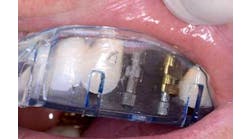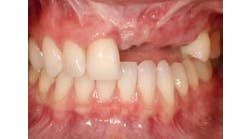NYU dental researcher awarded $1.9 million NIH grant to test new glass zirconia composite crown
Oct. 5, 2012
Dr. Yu Zhang, an associate professor of biomaterials and biomimetics at the New York University College of Dentistry, has been awarded a five-year, $1.9 million grant from the National Institute of Dental and Craniofacial Research (NIDCR), National Institutes of Health (NIH), to develop and test a prototype glass-zirconia composite dental crown.
The award enables Dr. Zhang to advance earlier research on a glass-zirconia composite formulation intended to serve as an alternative to porcelain-veneered zirconia designs. An estimated 10% of porcelain-veneered zirconia restorations develop fractures within the first three years. “A composite crown with glass-rich surfaces will be less susceptible to top-to-bottom fractures from direct contact with hard food as well as to ruptures that occur when the bottom of the restoration buckles under pressure,” predicts Dr. Zhang. Dr. Zhang formulated the initial prototype glass-zirconia composite material with funding from the NIH and the National Science Foundation (NSF), which awarded him more than $1.4 million in 2007 and 2008, respectively. His prior research showed that the glass-zirconia composite has significantly higher load-bearing capacity than porcelain-veneered zirconia formulations. “In this new study, we will be using a mouth motion simulator — a machine that simulates chewing and grinding — to compare the fracture-resistance of eight glass-zirconia and eight all-zirconia crowns,” said Dr. Zhang. “Each crown will endure two months and 1.25 million chewing cycles in the simulator — equivalent to three meals a day over a five-year period,” he said. Dr. Zhang’s glass-ceramic composite crown design has a predominantly glass surface with underlying layers that gradually become more densely packed with ceramic. The crown offers esthetics comparable to a porcelain-veneered zirconia version, but since it is thinner, less healthy tooth structure needs to be removed to make room for it. If the glass-ceramic composite crown proves more durable than the all-ceramic variant, Dr. Zhang plans to conduct a subsequent study examining the safety and efficacy of glass-ceramic crowns in human subjects. Dr. Zhang’s co-investigators include Dr. Van P. Thompson, professor and chair of the Department of Biomaterials and Biomimetics; Dr. Melvin Janal, adjunct associate professor of epidemiology and health promotion, both at the NYU College of Dentistry; Dr. Brian R. Lawn, an NIST Senior Fellow; and Dr. Herzl Chai, a professor of mechanical engineering at Tel Aviv University. Dr. Zhang joined the NYU College of Dentistry in 2005 after working as a materials scientist at NIST, the Maryland-based National Institute of Standards and Technology.About New York University College of Dentistry Founded in 1865, New York University College of Dentistry (NYUCD) is the third oldest and the largest dental school in the US, educating more than 8 percent of all dentists. NYUCD has a significant global reach and provides a level of national and international diversity among its students that is unmatched by any other dental school.







